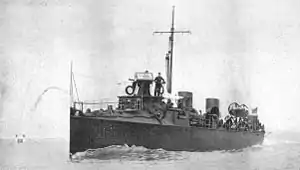 HMS Hunter | |
| Class overview | |
|---|---|
| Name | Handy class |
| Builders | Fairfields, Govan |
| Operators | |
| Preceded by | Banshee class |
| Succeeded by | Sunfish class |
| Built | 1895 |
| In commission | 1895–1914 |
| Completed | 3 |
| Retired | 3 |
| General characteristics | |
| Type | Torpedo boat destroyer |
| Displacement | 275 long tons (279 t) |
| Length | 194 ft (59 m) |
| Propulsion | Thornycroft boilers, 4,000 hp (2,983 kW) |
| Speed | 27 knots (50 km/h; 31 mph) |
| Complement | 53 |
| Armament |
|
Three Handy-class destroyers served with the Royal Navy. Handy, Hart and Hunter were all built by Fairfield.
Design and construction
As part of the 1893–1894 Naval Estimates, the British Admiralty placed orders for 36 torpedo-boat destroyers, all to be capable of 27 knots (50 km/h; 31 mph), as a follow-on to the six prototype "26-knotters" ordered in the previous 1892–1893 Estimates. Of the 36 destroyers, three ships (Handy, Hart and Hunter) were ordered from Fairfield Shipbuilding and Engineering Company of Govan,[1] the first torpedo craft to be built by that shipyard.[2] As typical for torpedo craft at the time, the Admiralty left detailed design to the builders, laying down only broad requirements.[3][4]
Fairfield's design was 197 feet (60.05 m) long overall and 194 feet (59.13 m) between perpendiculars, with a beam of 19 feet 5 inches (5.92 m) and a draught of 7 feet 6 inches (2.29 m). Displacement was 275 long tons (279 t) light and 310 long tons (310 t) full load,[2] while the ship's complement was 53 officers and men.[5] Three Thornycroft boilers fed steam at 215 pounds per square inch (1,480 kPa) to two 3-cylinder triple expansion steam engines rated at 4,000 indicated horsepower (3,000 kW) and driving two propeller shafts.[2] Two funnels were fitted.[6] Armament consisted of a single QF 12 pounder 12 cwt[lower-alpha 1] gun and three 6-pounder guns, with two 18 inch (450 mm) torpedo tubes.[7] As a gunboat, one of the torpedo tubes could be removed to accommodate a further two six-pounders.[8][9][lower-alpha 2]
In September 1913 the Admiralty re-classed all the surviving 27-knotter destroyers as A Class, although this only applied to Handy herself as the other two ships had already been sold for scrap in 1912.
See also
References
Notes
- ↑ "Cwt" is the abbreviation for hundredweight, 12cwt referring to the weight of the gun.
- ↑ While many of the 27-knotters later carried both the two torpedo tubes and all 5 six-pounder guns, stability concerns prevented Handy from following suit.[10]
Citations
Bibliography
- Brassey, T.A. (1897). The Naval Annual 1897. Portsmouth, UK: J. Griffin and Co.
- Brown, David K. (2003). Warrior to Dreadnought: Warship Development 1860–1905. London: Caxton Editions. ISBN 1-84067-5292.
- Chan Lau Kit-Ching (1990). China, Britain & Hong Kong 1895–1945. Hong Kong: The Chinese University Press. ISBN 962-201-409-7.
- Chesneau, Roger; Kolesnik, Eugene M, eds. (1979). Conway's All The World's Fighting Ships 1860–1905. London: Conway Maritime Press. ISBN 0-85177-133-5.
- Colledge, J. J.; Warlow, Ben (2006) [1969]. Ships of the Royal Navy: The Complete Record of all Fighting Ships of the Royal Navy (Rev. ed.). London: Chatham Publishing. ISBN 978-1-86176-281-8.
- Crowe, George (1903). The Commission of H.M.S. Terrible: 1898–1902. London: George Newnes.
- Friedman, Norman (2009). British Destroyers: From Earliest Days to the Second World War. Barnsley, UK: Seaforth Publishing. ISBN 978-1-84832-049-9.
- Gardiner, Robert; Gray, Randal, eds. (1985). Conway's All The World's Fighting Ships 1906–1921. London: Conway Maritime Press. ISBN 0-85177-245-5.
- Lyon, David (2001). The First Destroyers. London: Caxton Editions. ISBN 1-84067-3648.
- Manning, T. D. (1961). The British Destroyer. London: Putnam & Co. OCLC 6470051.
- March, Edgar J. (1966). British Destroyers: A History of Development, 1892–1953; Drawn by Admiralty Permission From Official Records & Returns, Ships' Covers & Building Plans. London: Seeley, Service. OCLC 164893555.